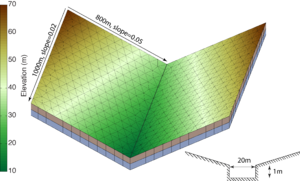Details on how to do this task: Make data accessible
We provide two data sets for the PIHM modeling (we use PIHM2.2 to avoid any discrepancy).
The first case is a benchmark problem: V-catchment. Here we prepared the input files for the V-catchment simulation. The V-catchment is benchmark example for the 2-D overland surface flow coupled with channel routing
"P. Di Giammarco et al., 1996". In the benchmark example, a rainfall event of 90-minute duration, 3e-6 m/s is applied on the V-catchment. The runoff at the outlet is usually compared for model validation. In this section, we shows how to use PIHM simulate the rainfall-runoff response of the V-catchment. PIHM uses a triangular mesh to represent the domain. The grid resolution may vary according to the users' requirement. Here, we used 782 triangles ( the area ranges from 1534.9m
2 to 2379.5m
2, with an average of 2046.0m
2) to represent the domain
. The users need the following steps to finish the V-catchment simulation:
1. Install PIHM on your computer.
2. Download input files of V-catchment at [1].
3. Run PIHM by the command "./pihm".
4. Plot the column 18 of "vcat.rivFlx1".
You will be able to see the runoff response as Figure 2.

Figure 2: PIHM modeled hydrograph of the V-catchment
Another simulation is PIHM application at a real watershed. Please find the details about the original application at
"Qu and Duffy, 2007". Here we demonstrate how to reproduce the simulation. The watershed data is from the experiment in 1974, at Shale Hills, PA. The rainfall runoff responses are shown in Figure 3

Figure 3: Rainfall runoff responses during the irrigation experiment in 1974.
.


